This is a Flexaret VII Twin Lens Reflex camera made between the years 1966 – 71 by Meopta, a camera company based out of the former Czechoslovakia. The Flexaret VII was the very last, and most advanced, in a line of TLRs dating back to the Kamarad Mk II from 1937. Meopta changed owners and names over the course of their history, but they were the most successful of all Czech camera makers, and the Flexaret TLRs are one of the highest regarded camera marques not made in Germany or Japan.
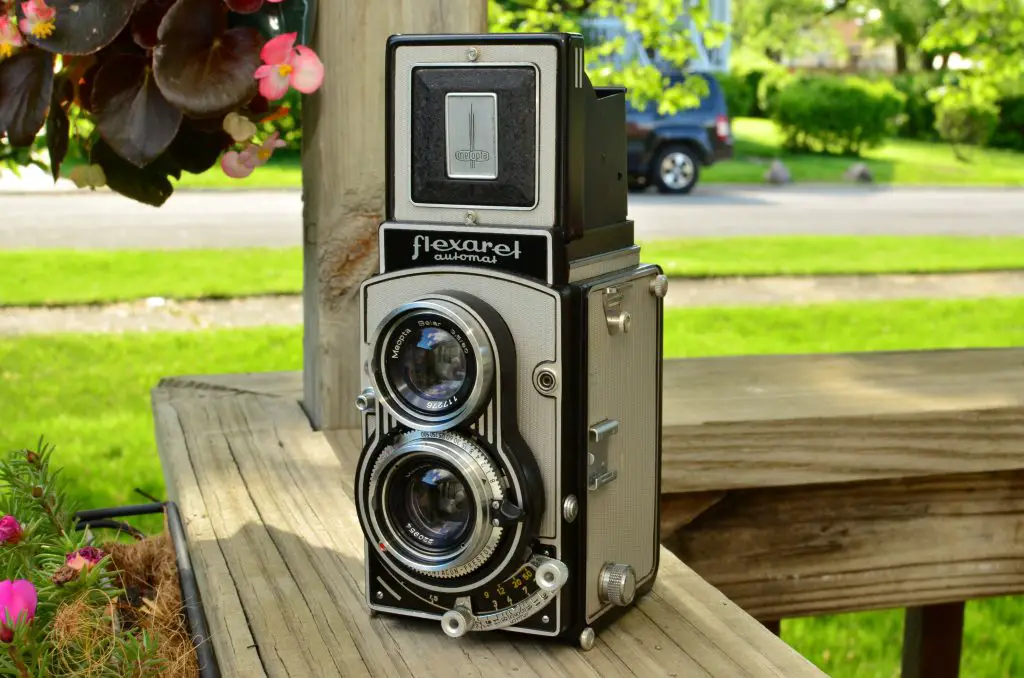 Film Type: 120 (35mm with adapter)
Film Type: 120 (35mm with adapter)
Lens: 80mm f/3.5 coated Meopta Belar 4 elements (both Taking and Viewfinder lenses)
Focus: 1m to Infinity
Type: Coupled Reflex Viewfinder
Shutter: Pentacon-Prestor RVS Leaf Shutter
Speeds: B, 1 – 1/500 seconds
Exposure Meter: None
Manual: http://www.cameramanuals.org/pdf_files/flexaret_vii.pdf
History
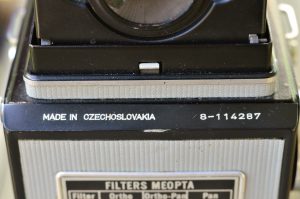
Growing up in the United States, we were taught a bit about European history in school. In high school, I took a class called Western Civilization which mostly focused on the growth of Europe from 1500, up until the mid 20th century.
We talked a lot about the Roman and Ottoman Empires, the struggles of England and France, and how western colonization helped form the basis for the US. Towards the end of the school year, we got into the first and second world wars and how the Soviet Union was formed. While I am sure countries like Czechoslovakia came up in school, for the life of me, I cannot remember anything I would have learned.
The world is a big place and many countries have deep and rich histories and sadly, there is only so much time that can be spent on one area, and this is a part of the world I know little about. When it comes to technology and precision instruments like cameras, you always think of Germany, Japan, the United States, and even England. Sure, I know other countries like France and Italy made their own cameras, but before I started collecting cameras, I would have never thought that there was (actually, they’re still in business) a very reputable camera maker in what is now the Czech Republic.
Meopta was founded in 1933 as Optikotechna in Přerov, Czechoslovakia. The company made all kinds of optics related products such as condensers and lenses. Their lenses were used by other manufacturers for enlargers, binoculars, projectors, and cameras. As the company grew, they started making their own cameras, binoculars, rifle scopes, and slide projectors.
By the mid 1930s, as tensions grew in Europe, Optikotechna became a major supplier of military optics for the Czech military. Once war broke out and Germany occupied the country, Optikotechna continued making military optics for the German war effort.
In 1938 (some sites say 1939), Optikotechna bought out a company called Bradac Brothers who made a couple of different Twin Lens Reflex models known as the Kamarad I and II, the Autoflex, and Optiflex. This line of cameras would be re-released as the Flexette in 1939, which would be the basis for future Flexaret models.
After the war, the company was nationalized and renamed to Meopta, which is short for Mechanická Optická Výroba, which means ‘mechanical optical manufacturing’ in English. Although Meopta continued production of optical equipment for their military, they continued to expand as one of the world’s largest suppliers of cinema projectors in the 50s and 60s. By 1955, as a result of decreased need for military applications, Meopta strongly shifted their focus towards civilian products.
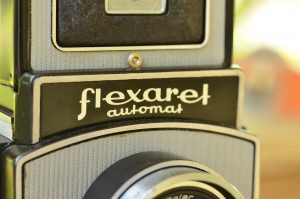 The Flexaret I was released in 1939 and was very similar to the earlier Flexette, Optiflex, and Autoflex models that preceded it, however it was the first to be fitted with Optikotechna lenses. These early models had Compur and Prontor shutters with a max shutter speed of 1/250 sec.
The Flexaret I was released in 1939 and was very similar to the earlier Flexette, Optiflex, and Autoflex models that preceded it, however it was the first to be fitted with Optikotechna lenses. These early models had Compur and Prontor shutters with a max shutter speed of 1/250 sec.
After the war, the Flexaret II and IIa were released. The Flexaret IIa from 1947 was the first TLR released under the new Meopta name and had the company’s own Meopta Mirar 80mm f/4.5 lens and Meopta Metax shutter which was capable of 1/400 sec.
Over the course of the next two decades, the Flexaret models would continue to evolve adding or changing a feature or two at a time culminating with the top of the line Flexaret VII from 1966. There was never a time when the Flexaret was completely redesigned.
Here are some design highlights of the entire line:
- Other than the Flexaret III and IIIa, all Flexarets had a knob wind instead of a crank like on the Rolleiflex.
- Starting with the Flexaret II, they all had a swiveling focus lever beneath the taking lens. This taking lever was redesigned as a long curved piece of metal with a depth of field scale in between dual knobs on the Flexaret V. The Minolta Autocord had a very similar type of focusing system which is said to be easier to use one-handed.
- All Flexaret models except the VI, VII, and Standard were covered in black leatherette. These 3 models came in a silver/gray cloth-like material.
- The Flexaret VI and VII are the only two “Automat” models which mean they have an automatic film counter which is coupled to the film advance mechanism.
- Most models after the Flexaret V (with the exception being the Standard) had an optional adapter for 35mm film, although all Flexarets were designed primarily for 120 roll film.
- The Flexaret VII was the only model that had a shutter capable of 1/500 seconds, every other Flexaret had a top speed of 1/400 or less. The Flexaret VII also had an adjustable “transmission” that allowed for 6cm x 4.5cm shots to be taken with a baffle inside of the film compartment. You would switch between 6×6 and 6×4.5 size shots by turning a dog bone shaped piece of metal on the side of the camera.
- No Flexarets ever came with any type of automatic exposure system or light meter, and as such, none require batteries.
Although the Flexaret line of TLRs was Meopta’s signature line, they did have a few other models, namely a 35mm interchangeable lens model called the Opema.
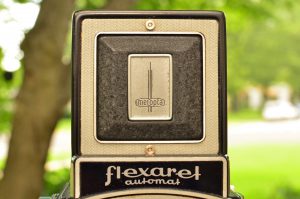 In the late 1960s, the Soviet Union continued to force it’s influence on Czechoslovakia, which caused supplies for the Flexaret models to become increasingly difficult to maintain. As a result of changing communist political pressure, Meopta discontinued making civilian cameras around 1971 and focused on other products for the Optics industry.
In the late 1960s, the Soviet Union continued to force it’s influence on Czechoslovakia, which caused supplies for the Flexaret models to become increasingly difficult to maintain. As a result of changing communist political pressure, Meopta discontinued making civilian cameras around 1971 and focused on other products for the Optics industry.
I couldn’t find a lot of information about what Meopta did in the 1970s and 1980s. Even the “History” section on Meopta’s current website only has one entry each from the 70s and 80s with a very vague description that they continued to make other military products for Warsaw pact countries and that they made rifle scopes. Somehow they managed to survive through the collapse of the Soviet Union, and in 1992, became a privately owned company once again.
In the 60s, Meopta would partner with a US company called Tyrolit (later TCI) who was based out of New York City and they have continued to maintain their relationship to this very day. In 2005, TCI was renamed Meopta USA, Inc and continues to be one of the world’s leading maker of optic products.
Today, Flexaret cameras have a very strong reputation as being one of the best TLRs, but for some reason, their values are nowhere near what comparable Rollei or Yashica models typically sell for. You can easily find Flexaret models with full CLAs on eBay for under $150. These are wonderful cameras that are made with the highest precision, and if taken care of throughout their life, continue to work well today.
If you are in the United States, you won’t find a lot of them for sale here, but if you’re willing to buy from International sellers, they are common throughout Europe.
My Thoughts
TLRs are an interesting type of camera. They look unlike any other camera, and when shooting with them in public, they often draw the attention of passers by.
My first TLR was a Yashica-Mat which strongly resembles the Rolleiflex of the 50s. Around the time I received my Yashica-Mat, I was told that the Flexaret VI and VII were excellent models to check out too, but being in the US, there weren’t many for sale. Since I am a cheapwad, I typically try to look at cameras for $50 or less, and never look for things over $100.
I had always loved the look of the Flexaret, but put it out of my mind since I doubted I’d find one in my restrictive price range. Then one day, some seller from Indiana had an auction for an “old” camera. He didn’t say what brand it was, or what model. He didn’t even show a picture of the camera. All I could see was the leather case, and I could very clearly make out “Flexaret VII” embossed into the leather. Taking a huge risk here, I bid on the “old camera” and won it for $25. When the camera arrived, I was delighted to see that not only was there an old camera in the case, but it was definitely a Flexaret VII!
According to this Czech language site (which you need Google to translate), the serial numbers on the Flexaret VII is in the format of X-YYYYYY where X is the last digit of the year it was made. Since Flexarets were made from 1966 – 1970, the possible values are 6, 7, 8, 9, and 0. Mine begins with an 8, so that means it was made in 1968.
The camera was in pretty good shape and appeared to be in operating condition. I did a quick wipe down of the body and lenses to get the grime off it, but I noticed that there was a lot of debris trapped inside of the viewfinder beneath the ground glass.
This is a pretty common problem with TLRs due to the large open cavity where the reflex mirror is. On my Yashica-Mat, I took the viewfinder off and was able to release the mirror from it’s clasp and give it a good cleaning. Sadly, the Flexaret isn’t as easy to disassemble. There are no visible screws or any obvious way to take it apart. I found a site online that mentions that the first step to disassembling it, is to remove the leatherette which hides some of the screws. Since the body and leatherette were in good shape, and the camera seemed to work, I didn’t want to risk doing any cosmetic damage to the body since it would have been nearly impossible to replace the covering on this camera. The viewfinder was dirty, and the ground glass had yellowed a bit, but it was still very usable. I was able to give the taking lens a good cleaning so I loaded in a roll of Kodak Ektar 100 and went shooting.
My Results
I’ve already mentioned that the Flexaret VII has a feature where you can change it over from 6cm x 6cm over to 6cm x 4.5cm by use of a baffle which is what I decided to do for my first roll. While I like square photography, I am not good at framing with the extra height, plus switching over to 6×4.5 gives you 16 exposures on a roll of 120 as opposed to 12.
The results speak for themselves, the Meopta lenses are outstanding. Remember that Meopta was an optics company first and a camera company second, so it should be no surprise that the pictures will be crisp, with excellent contrast and color rendition. I noticed no chromatic aberration or vignetting in the corners (although to be fair, I was using the 6×4.5 baffle).
Using the Flexaret VII has some similarities to other TLRs, but there are some big differences too. I’ll cover them in the order you’re likely to encounter them.
First, opening the back door is different from other TLRs. On the photographer’s left side of the camera, near the top, is a small knurled metal knob that must be unscrewed and then pressed to release the catch for the back door. The very first time I tried to open the door of my Flexaret, I couldn’t figure this out. It looks like you just push this knob in, but it doesn’t do anything unless you unscrew it first. Once you have closed the door, you screw it tight to keep the door latched. It’s a foolproof way of assuring the door will never accidentally open, but it’s not immediately obvious to a new user.
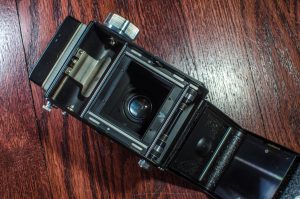
Before loading the film, you need to decide if you are going to shoot 6cm x 6cm photos, or 6cm x 4.5cm. If you’re going for 6×6, no special steps are necessary. Load the 120 film like you would on any other TLR. However, if you plan on shooting 6×4.5 photos, you must have the baffle in place prior to inserting the film. The baffle only goes in one way, so pay attention to the little protrusion and make sure it goes into the notch on the body otherwise it can fall out. See the image to the right showing the baffle correctly installed inside of the camera.
There is also a second baffle that goes into the viewfinder to represent a 6×4.5 image, but my Flexaret was missing this baffle. I was still able to approximate a 6×4.5 frame by not composing anything near the top or bottom of the viewfinder.
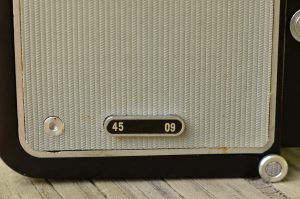
Next, you need to make sure that the transmission lever (this is what the manual calls it) which is that little dogbone shaped piece of metal on the lower right side of the camera with the numbers 60 and 45 on it is in the correct position. If the number 60 is upright and 45 is upside down, that means it is set for 6×6 photos. Pull the transmission lever out and rotate it 180 degrees so that the 45 is upright and 60 is upside down, and it will be set for 6×4.5 photos. If you cannot get a grip on the transmission lever, there is a metal pin you can push on from inside the film compartment that will push the transmission lever outwards from the body of the camera. This makes rotating it a lot easier.
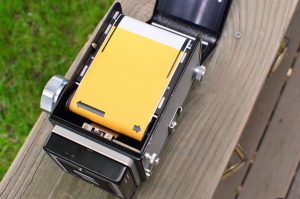
Once both baffles are in, and the transmission lever is correctly set with the number 45 in an upright position and 60 is upside down, the camera is ready for film. Normally when loading 120 film into a 6×6 camera, you must wind the film onto the take-up spool until the start indicator on the backing paper (which is usually a double sided black arrow) is lined up with two white dots inside of the film compartment. When shooting 6×6 photos on the Flexaret VII, this procedure is exactly how it is on other cameras. However, when shooting 6×4.5, you must line up the start indicator a little farther along, so that it is just starting to roll onto the take-up spool. a When the transmission lever is set for 6×4.5 photos, each frame advancement only advances the film enough for a 4.5 cm tall image instead of the full 6 cm. This is how you get 16 images on a single roll as opposed to 12. If you do not properly roll the film so that the Start indicator is on the take-up spool, the film will not be ready for the first frame.
Once the camera is loaded, you should turn your attention to the frame counters. Yes, that’s right, counters. There are 2 of them on this camera. The frame counter on the left has to be manually turned by the photographer and is not internally coupled to anything. This left counter has the numbers 0 through 4 on it. The right frame counter is coupled to the camera and goes from 0 through 9. When loading film into the camera, you must manually turn the left counter to 0, and the camera should automatically set the right frame counter to 1 indicating that you are ready for your first exposure.
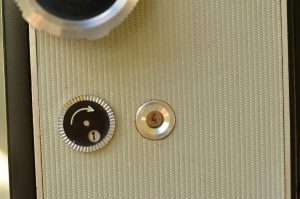
The idea is that as you take photos and advance the film, the right counter increments from 1 through 9. Once you reach the 10th exposure, the right counter goes to 0 and you must manually turn the left counter to 1, so that the left counter is 1, and the right counter is 0. The reason for this is because the Flexaret VII also supports 35mm film which allows for a lot more exposures than 120 film would. This dual frame counter system is needed to shoot rolls with 24 or 36 exposures. You can even use the 6×4.5 baffle with 35mm film and shoot 24mm x 24mm exposures on 35mm film. When doing this, a 24 exposure roll will get you 32 shots, and a 36 exposure roll will get you 48. It would have been a huge technological feat to make an automatic frame counter that could go all the way up to 48, so Meopta chose to do with this two counter method.
I’ve only ever used a Yashica-Mat and Mamiya C33 TLR before, so my range of familiarity with TLRs is not that great, but another quirk of this camera is that the film advancement knob has a lot of resistance when turning. Advancing the film requires a lot more effort than on the other two TLRs I’ve used. I’ve read that this is common among Flexarets, but it might be something that would concern a new user because it almost feels like something is wrong when you advance the film.
Once you are ready to shoot some photos with the Flexaret, the viewfinder works like any other TLR. There is a flip up magnifying glass that helps with fine focus, and there is a little door in the viewfinder lid that can be used as a “sports finder” for fast action shots.
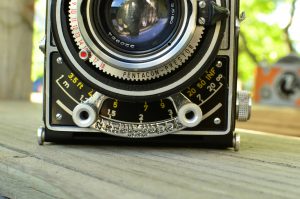
Focusing is pretty smooth and easy with the swiveling focus lever beneath the taking lens. This design is said to be easier to use one-handed, but in my opinion, using a TLR should always be a two handed task. My Yashica-Mat has a knob focus on the side of the camera which I find to be really easy to use. The Flexaret’s way isn’t any easier or harder, it’s just different. A cool feature of the focusing system is that you can use it with or without stops. If you want there to be stops, there is a little sliding lever on the left front side of the camera, right in front of the accessory shoe.
The last major difference is in selecting the aperture and shutter speed. The Flexaret uses a coupled Light Value Scale with EV numbers 3 – 18 that are supposed to help in selecting the correct exposure. This system is similar to the one on the Aires 35-III L which I have reviewed on this site. Read that review for a thorough explanation of a coupled LVS scale and how EV values are calculated. In a nutshell, all you need to do is know the EV value of a scene, set the camera to that value, and then you are free to change aperture or shutter speed and the exposure will always be the same.
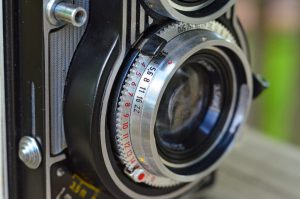
Personally, I don’t find this system better. When shooting outdoors, I prefer to use the Sunny 16 rule and set the shutter speed and aperture myself. You can still do this with the Flexaret, but it involves pulling back on the black lever pointing to the red EV values, and keep it held back while selecting your chosen shutter speed and aperture. If you let the black lever return to it’s “normal” position, it locks the shutter speed and aperture to whatever EV value the lever is pointing at. This is a little hard to explain, but if you have a Flexaret VII in front of you, it should be pretty obvious how it works. The Flexaret manual linked at the top of this review has a decent explanation of this system on page 18 of the PDF manual (its the one that someone hand wrote the number 10 in the upper right corner of the page.)
At this point, you are ready to make your first exposure. Since the shutter is coupled to the film advance, there is no separate procedure to cock the shutter. If you are sure the shutter has been cocked, and the shutter release button cannot be pressed, check that the shutter is not locked via the sliding lever above the shutter release. A red dot will be visible when the shutter is unlocked. To lock it, slide the locking lever towards the direction of the red dot.
After making an exposure, it is advised not to advance the film to the next frame because this also cocks the shutter. You should only cock the shutter when you are ready to take another exposure, because according to the manual, storing the camera for an extended length of time with the shutter cocked can cause the tension spring to weaken and possibly fail.
As you can see, there are a lot of things to know before shooting with a Flexaret. Whether that’s a good thing or a bad thing is entirely up to you. The best news is that the Meopta lenses are very good, so if you’re willing to try something a little different from other TLRs, you will be rewarded with some spectacular shots. The Rolleiflex was such a great camera, that it was copied by almost everyone, and for me, that can get a little boring. Meopta went with their own formula and developed a truly world class camera.
I really wish I could get the viewfinder clean, and possibly even replace the ground glass with one that hasn’t yellowed. Compared to my Yashica-Mat in outdoor scenes, the difference is noticeable, but not a deal breaker. Indoors however, the yellowing and dirt can get in the way. Maybe I’ll spring for a CLA some day, or become brave and try disassembling it myself. Until then, this is still a very capable shooter that I look forward to shooting with again.
Additional Resources
http://www.tlr-cameras.com/Czech/
http://camerapedia.wikia.com/wiki/Flexaret_VII
http://en.wikipedia.org/wiki/Flexaret
http://theartofphotography.tv/episodes/185-flexaret-vii/
http://www.novacon.com.br/odditycameras/flexaretorder.htm
http://www.flexarety.cz/flexaret-vii/ – This is a non-English site, but it translates to English well.

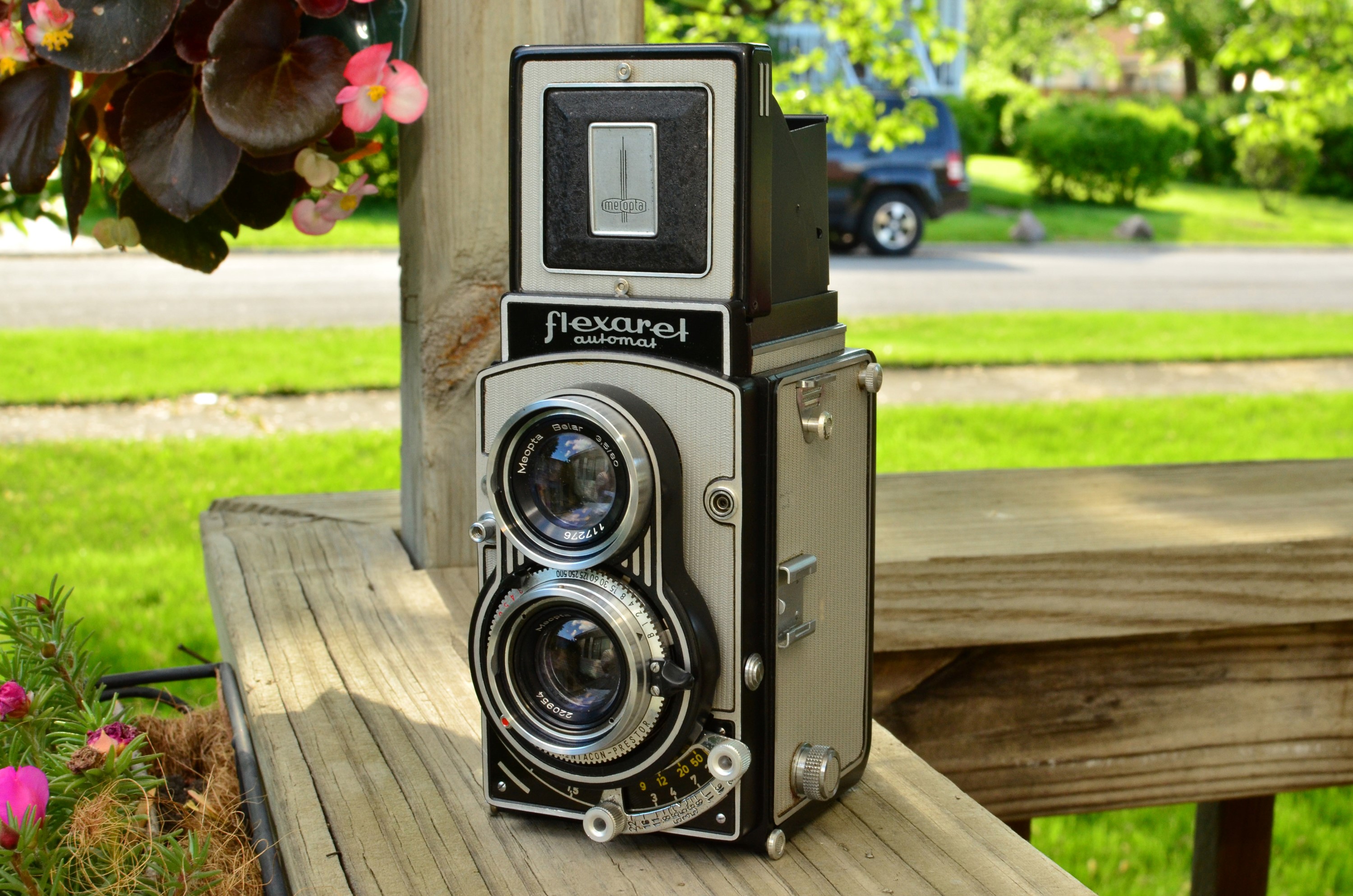
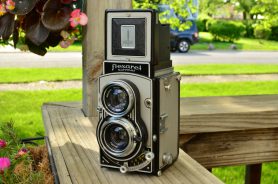






Awesome article on the Flexaret. I purchased one in the early 2000’s but have yet to run film through it because of the dark viewfinder/mirror. I hear that is is common with this line of TLR’s. I did check into having the mirror replaced but it would have cost about more than I originally paid for the camera. Your points praising the camera are spot on though, it is an extremely well-made camera, nice and heavy – quality.
Hello Ken, I make replacement mirrors for a variety of TLR’s and the Flexaret’s are some of them. The price of the mirror is $7.50 plus shipping. You can contact me at [email protected]
Thank you for the kind words. I am torn with this camera. Although I find my Yashica-Mat ever so slightly easier to use, and the viewfinder in the Yashica is bright and clean, I love the ability to shoot 6 x 4.5 images in the Flexaret. Not only do I get an extra 4 exposures out of a roll, I prefer the aspect ratio of that over the 6 x 6. In either case, I have 2 excellent TLRs to choose from which is a good problem to have! 🙂
Very nice article, I was born in Czechoslovakia and I learned a lot of new things here. They don’t teach us our own modern history so much in school here either, partly because the people are only slowly losing their fear of censorship and police informers. After 1968, there was a period called “normalisation”, which was pretty grim, the Soviets came with tanks and were shooting up buildings like the national museum to kill our national pride. So this might be the reason for Meopta’s inactivity thereafter.
Also, one fun fact-every kid going to school in the 90s like me, knows one product of Meopta – the beloved Meotar 🙂 it was an overhead projector and every school had a couple. It was the most exciting thing, after PE and IT classes.
Regards,
Lukas
Lukas, thanks for the compliments and thank you very much for the historical insight to your country’s past, even though it was a bit grim. We had those kinds of overhead projectors here in the US too, although Im sure they weren’t the Meotar. Kids these days will never know the pleasure of seeing your teacher writing on the wall! 🙂
Mike, thank you so much for this great article and review. It is very helpful. I have just purchased a working copy of Flexaret VII and I like to shoot in 6×4.5 format. My camera did not come with any baffles so I purchased a Flexkin kit on eBay. It has several baffles so I am not sure which one to use.
Do you have a picture of your baffle and one showing how to place it inside film compartment? I’ll appreciate to see it.
Also, what is the right way to move the transmission lever to the 45 position? I tried moving mine but it did not budge. Do I have to pull on it? I am assuming it has to be moved clockwise from its current 60 position. Thank you.
Kam, thank you for the kind words.
I cannot post images in comments, so I will update the main part of the review to include an image of the film compartment with the 6×4.5 baffle in place. It is a simple metal frame that merely slides into position. I believe when this camera was new, there would have also been a baffle that would rest on top of the ground glass to give you a 6×4.5 image on the ground glass, but mine is missing that part.
In regards to the transmission lever, to move its position, you must pull it out (away from the camera) and then rotate it 180 degrees to the other position. It is very hard to get a grip on from outside of the camera, so to make it easier, if you open the film compartment, there is a little pin behind the lever that you can push out on that will allow you to grip it. Once you pull it out, it can be turned clockwise or counter clockwise, it does not matter.
Good luck with your camera!
Mike, thank you so much. I appreciate you updating the review with the image. It made things totally clear for me. I was placing this baffle upside down. I just bought some 120 film. Camera is all set and I can’t wait to go for a walk one of these days.
Once again, many thanks for your wonderful blog. It has been a valuable aid and a joy to read.
Mike, my Flexaret VII just arrived today and I have to say as much as I love my Rolleiflex 3.5E, my vote will have to go to the Flexaret VII if there was a beauty contest for TLR cameras. Thank you so much for this excellent article, it taught me how to properly operate this mechanical masterpiece. I can’t wait to test out Meopta’s reputable optics! I believe this Art Deco beauty will be a joy to use and permanently stay in the collection.
Great article! Thanks your insight. I, for one, thought I might break the camera when advancing the film/cocking the shutter. It is so ‘stiff’, I thought I might be “forcing” something. Appreciate your observations…
I found a like new, complete, Flexkin adapter kit with case. Allows 6×4.5, 35mm, and 24mm square (on 35mm film). It includes all the masks for the waist level and sport finder, too.
Looking forward to trying 645, and may run a roll of 35 through as well.
Happy shooting!
Great Article. Thanks for the insights.
Hi, I’ve found old Flexaret and wanted to know about it more… And I want to thank you a lot! As a native czech I found the article more helpful than lot of czech ones thank you
Thanks Antoine, I am glad that you found the review so helpful!
Starting in the late 1950s, Meopta made several photo enlargers, at least one of which was imported into the US. I used their 35mm model at school in the early 1960s. The build quality was better than any of the US made enlargers of the day. I believe that they continued to make higher end enlargers for several more decades. They are quite common in Europe, but rare in the US. In the 1990s and later, they also sold in Europe a variety of enlarging lenses, the top models being the equal of any made by Schneider, Rodenstock or Nikon ( and just as expensive).
Thanks for the Meopta history Randall! I was aware they made more than just cameras, but it’s good to know their high quality extended to their other products as well.
Hi Mike, great article about Flexaret. As a long time collector of the Flexaret cameras I would like to point out some facts.
Optikotechna bought rights to make Flexette and Autoflex cameras from Brothers Bradáč, not the whole Bradáč company in the 1938, because after Muchen agreement they lost almost all military contracts.
In 1939, they just renamed cameras from Flexette to Flexaret (I) and from Autoflex to Optiflex (Optiflex was very expansive and it is very rare).
Flexaret II wasn’t introduced after the war but in 1940. Optikotechna also developed and made first Flexaret III during the war.
Flexaret IIa was introduced when Flexaret III started to hit store shelves as cheaper and simpler alternative and it was made together with models III, IV and V and was replaced by model Standard introduced with model VI.
You can say between model V and VI there was a major redesign.
Some models IV also had long curved metal with depth of field scale.
There is some number of model V with green leather, this leather was used by Meopta also on camera called Optineta made at same time. You can find Flexaret VI (first series) with black leather and also there is flexaret VII black.
Optional adapter for 35 mm is available since model IVa (V, Va, VI, VIa, VII, VIIa), but not for IIa or Standard, but with Standard you can easily switch to 6×4,5 by just adding mask. Important is to find correct
adapter because it was developed during time and some of them are not compatible.
Flexaret VII is not the only camera capable of 1/500sec, it depends on shutter used. There are models II and III equipped with Compur Rapid with 1/500sec and Flexaret VI with Prontor SVS with 1/500sec.
There is prototype of Flexaret V with integrated light meter.
In US, you can find some Flexaret III originally sold in US, in the late 40s and early 50s Meopta shipped Flexaret III in to US and some were probably even assembled in US. They are called Flexaret Crown (they have crown logo) and most of them is equipped with big US flash synchro on the side.
Format of serial number for model VI, VII and Standard is X-yyyyyy where X means year of production but latest models have 9, because in the year 1969 the production was officaly cancelled and in 1970, maybe also in 1971 some cameras were completed
from parts available on the stock.
Yellow/brown grown glass is additional plastic fresnel lens added to grounded glass and it can be removed, no need to replace glass itself.
Excellent and well documented previous comment by Miroslav, which complements Mike’s interesting article. A good website about Flexaret (in German, but concise and complete) is http://www.hmw-foto.at/flexaret/
Thanks for the compliment and the link Luis. I will definitely check it out!
Just a small, but important remark. Flexaret Va, which I own, has viewfinder lens at aperture 3, while lens taking pictures starts at 3,5. Flexaret VII has both lens at 3,5. Advantage for viewfinder lens at aperture 3 is, that it has lower depth of field so focusing with aperture 3 assures a better quality and faster focusing procedure.